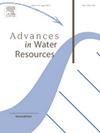非单调润湿效应的新认识:两相驱替时最小运行功率原理
IF 4
2区 环境科学与生态学
Q1 WATER RESOURCES
引用次数: 0
摘要
基于最小工作功率原理,分析了多孔介质中非单调润湿效应的潜在控制机理。当系统施加不同的润湿条件时,在系统接近最小运行功率状态的过程中,不同能量贡献项的贡献权重不同。对于弱排水或弱吸胀的润湿体系,固-液和液-液表面能变化率的贡献权重是相当的。该体系可能存在固液和液液两种表面能变化率交替为主的一系列阶段,这为毛细管能量屏障调节机制的存在奠定了基础。此外,在界面重建过程中,高比表面积区域的固液表面能变化率起主导作用,导致了合作机制(Haines跳变事件)和非合作机制(接触、重叠事件),这也为优先流路和致密位移状态的形成奠定了基础。而对于强吸胀润湿体系,固液表面能变化率的贡献权重开始占主导地位,毛细能量屏障调节机制消失。该系统最大限度地提高固液表面能变化率,使其接近最小工作功率状态,从而在表面凹槽或孔角处形成弧形半月板,其推进速度远高于终端半月板。以弧形半月板为主的优先流道状态再次出现。本文章由计算机程序翻译,如有差异,请以英文原文为准。
New insights into the nonmonotonic wetting effect: The principle of minimum operating power during two-phase displacement
In this study, based on the minimum operating power principle, the potential control mechanism of nonmonotonic wetting effects in porous media is analyzed. When different wetting conditions are applied to the system, the contribution weights of different energy contribution terms are different during the process when the system approaches the minimum operating power state. For weak drainage or weak imbibition wetting systems, the contribution weights of the solid‒liquid and liquid‒liquid surface energy change rates are comparable. The system may have a series of stages in which the solid‒liquid and liquid‒liquid surface energy change rates alternate in dominance, which lays a foundation for the existence of a capillary energy barrier regulatory mechanism. In addition, during interfacial reconstruction, the solid‒liquid surface energy change rate in high specific surface area regions plays a dominant role, resulting in a cooperative mechanism (Haines jump events) and noncooperative mechanisms (contact, overlap events), which also establishes a basis for the formation of preferential flow paths and compact displacement states. However, for strong imbibition wetting systems, the contribution weight of the solid‒liquid surface energy change rate begins to dominate, and the capillary energy barrier regulatory mechanism disappears. The system maximizes the solid‒liquid surface energy change rate to approach the minimum operating power state, resulting in an arc meniscus at surface grooves or pore corners with a much higher advancing speed than that of the terminal meniscus. The preferential flow path state dominated by the arc meniscus reappears.
求助全文
通过发布文献求助,成功后即可免费获取论文全文。
去求助
来源期刊

Advances in Water Resources
环境科学-水资源
CiteScore
9.40
自引率
6.40%
发文量
171
审稿时长
36 days
期刊介绍:
Advances in Water Resources provides a forum for the presentation of fundamental scientific advances in the understanding of water resources systems. The scope of Advances in Water Resources includes any combination of theoretical, computational, and experimental approaches used to advance fundamental understanding of surface or subsurface water resources systems or the interaction of these systems with the atmosphere, geosphere, biosphere, and human societies. Manuscripts involving case studies that do not attempt to reach broader conclusions, research on engineering design, applied hydraulics, or water quality and treatment, as well as applications of existing knowledge that do not advance fundamental understanding of hydrological processes, are not appropriate for Advances in Water Resources.
Examples of appropriate topical areas that will be considered include the following:
• Surface and subsurface hydrology
• Hydrometeorology
• Environmental fluid dynamics
• Ecohydrology and ecohydrodynamics
• Multiphase transport phenomena in porous media
• Fluid flow and species transport and reaction processes
 求助内容:
求助内容: 应助结果提醒方式:
应助结果提醒方式:


